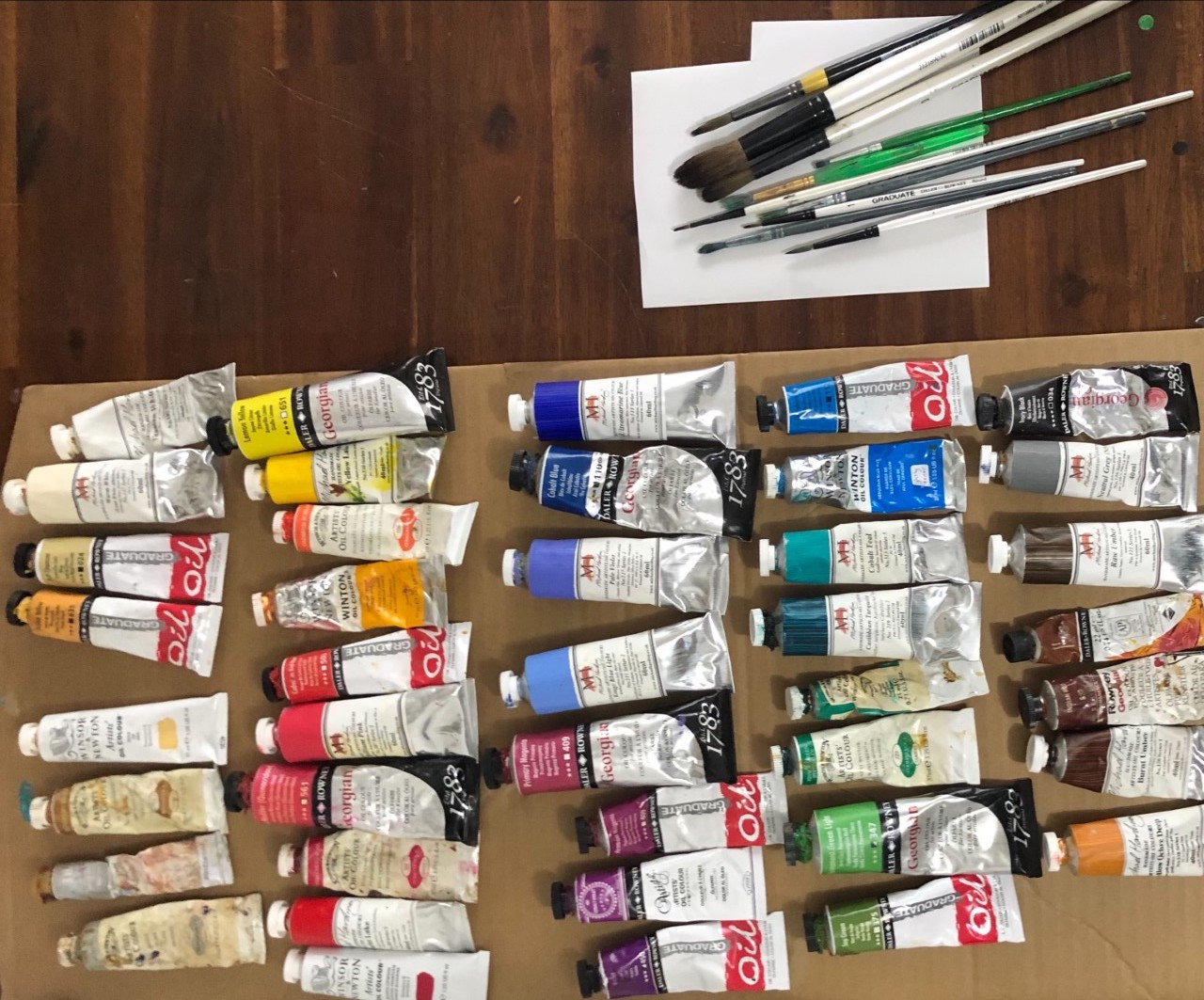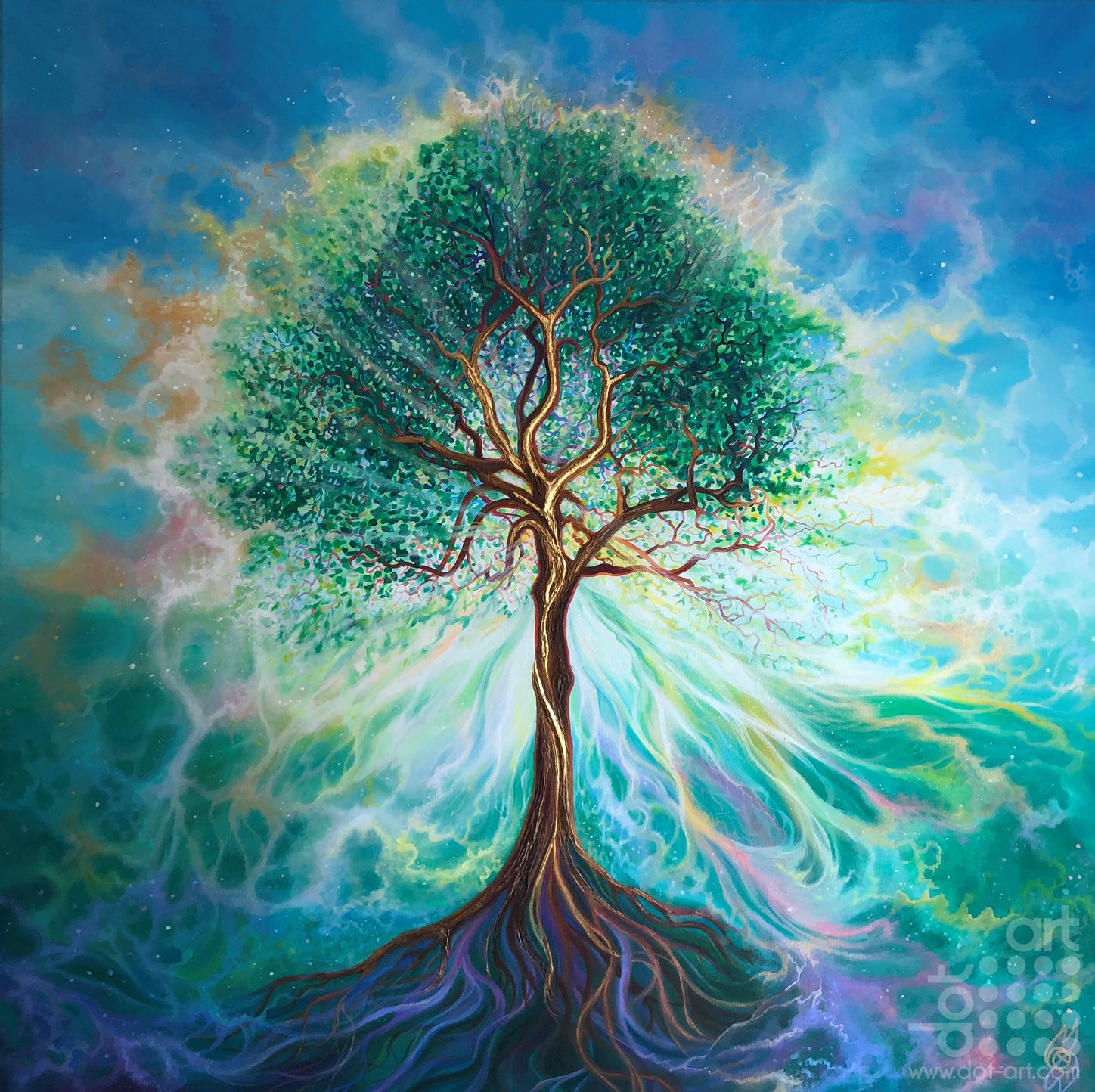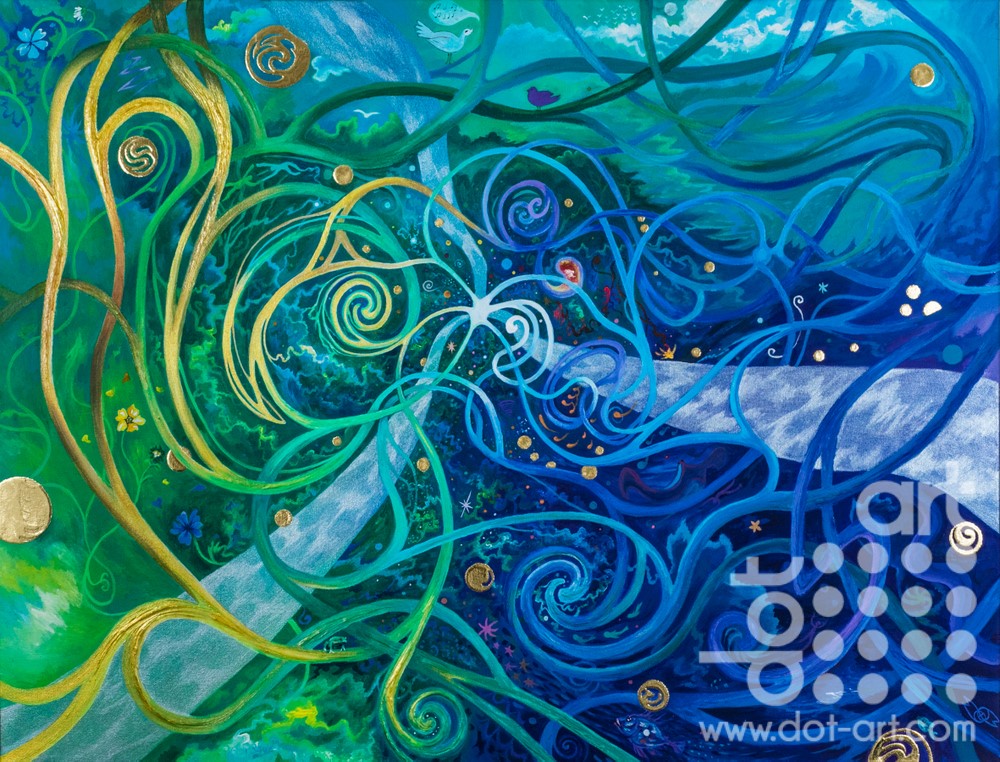“I feel paintings can increase people’s visual fluency and be a positive, therapeutic presence in our lives.”
Join us as we get to know more about dot-art member Madeleine Pires’ creative practice in this months featured artist blog.
In the Studio Madeleine Pires
Which medium do you work with and what do you like about it specifically?
I paint primarily with oil on canvas, although I do use acrylic paint and water-based texture pastes as a base layer for some of my paintings. For my nebula-esque paintings, nothing quite compares with oil paints, because of the number of layers they require.
The paint also needs to be able to move around on the canvas in order to blend and to get the smoky, cloudy textures. Oil paint provides the freedom of movement and the slow drying time necessary to achieve all of the grandeur and detail the works require.
I use mainly Michael Harding – his opaques are particularly good quality – and Winsor and Newton Artists Oil Colour.
Oil paint is particularly good for glazing (mixing with linseed oil to get a transparent quality) and this is important for me when there is a central light area, especially if it is glowing. Like watercolourists do, I make use of the whiteness of the surface shining through, while I build up other thicker areas, sometimes with Michael Harding’s beeswax mixed into the paint to add texture and contrast.
Certain “harmonious” shapes emerge throughout the process, some of which I feel captures the “essence” of the painting. For these rare occurrences, I use the gilding technique with 23.75 karat gold leaf, once the painting is completely dry.

Describe your style of art:
Based on the traditional disciplines of fine art, my style of art is realistic yet semi-abstract at the same time. As a child, I was always praised for my observational drawing ability.
But just the skill of being able to represent something realistically was not enough. I decided to experiment with different ways of portraying landscapes, trees and skies – scenes so important to me – in a more dramatic way, trying to transmit the passion and what I felt resonating in me from them.
I called it “heightened realism” – emphasising or exaggerating certain elements and leaving out other parts to reveal the “essence” of something. There could be similarities with Expressionism, in that I am portraying my feelings as well as what I see.
Like many oil painters, I use multiple layers, going through hundreds of tiny paintbrushes to achieve the level of detail and multi-faceted complexity which is meant to be refreshing, stimulating and inspiring to the eye.
In most of my pieces, a “light source” will feature somewhere. I think this happens subconsciously as if I’m trying to hint at a world beyond which is veiled yet partly revealed at the same time. The visual language of my nebula/cosmic pieces has developed a sort of signature style: “glory waves” or “ethereal wispiness”.
My pieces are full of reconciled contradictions and “harmonious opposites”. The cosmic ones, being based on areas of the universe that are inaccessible for most of us, can be disarming yet not shocking; foreign yet familiar; mysterious yet knowable.
I aim to create art that transports people to a different place where human restrictions are suspended and the imagination can be used and enjoyed. This style of art aims to have a balance of passion and serenity; clarity and obscurity; wildness and tenderness; simplicity and complexity; surprise and familiarity.
 Can you talk us through your process? Do you begin with a sketch, or do you just go straight in? How long do you spend on one piece? How do you know when it is finished?
Can you talk us through your process? Do you begin with a sketch, or do you just go straight in? How long do you spend on one piece? How do you know when it is finished?
My large cosmic paintings are usually inspired by an actual nebula or part of a nebula, though I have started to create my own now. Often I sketch from a photo (or combination of photos) to pull out and enhance the shapes and colours that “speak” to me, and I leave out some areas and invent some of my own.
I do this with pastel pencils on a large piece of A3 black card. This helps me break the scene down into different visual components so that I can start the painting without being overwhelmed. I often write down the different things I need to do in a notebook, along with keywords that need to stay in my mind, and add to it as I go through each layer, with reminders for what I need to do next time. (This is particularly useful when I am working on more than one painting at a time.)
To start a nebula, I usually make myself boil the whole thing down into the extremes of light and darkness – no details, no mid-tones. For the first layer I cover most of the canvas with black acrylic paint and leave the light parts clear so that the surface of the canvas can shine through those really bright areas. Those light parts are the places where I will use transparent paints and glazes; the dark areas can be subsequently covered with more opaques and cloudy tones.
At this early stage I also start really focusing on large prominent shapes, and decide which areas need to be supported by texture paste or swathes of something on the surface to help describe it. This will usually be various pastes by Golden – they are water-based, so I need to use these early on in the process and let them dry completely before starting the second layer.
The second layer is probably the hardest, but also wonderful because I can finally make a beautiful palette of expensive oil colours! It is tempting at this stage to go into tiny details but I have learnt that it is better to block in the main shapes and areas of colour.
Nebulas are very abstract-looking and have odd-looking areas, with multiple colours and cloudy forms morphing into each other. It can be very difficult to capture these effects in one go: layering is the key. Experience has taught me that constructing a successful painting is a bit like building a house with a solid foundation. I use my ability to portray things realistically but also listen to my “inner whispers” which is more to do with intuition. As I get immersed into the painting, I gradually pay less attention to the photo and sketch and embrace what the canvas is becoming.
Standing back multiple times; going away and coming back with fresh eyes; “listening” to what the painting is trying to say: these are all critically important things in the process. The third layer captures the details, allows space for the “glory waves/wispiness to develop and really consolidates the “voice” of the particular painting.
Sometimes even I as the “creator” can be surprised at how the painting develops and finishes. Usually, I will hang it on the wall in a different room while it is still wet and observe it while passing through. I’ll invite family members and friends to give me their feedback. If it catches the eye and has the power to “pull” the viewer into a different place, and seems to have a balance, it is finished.
When did you begin your career in art?
I was very fortunate to have parents who nurtured and affirmed my aptitude for art from an early age. It made sense for me to go to university and do a degree in Fine Art at age 18. This exposed me to different styles of art, particularly contemporary and conceptual art. When I left university I worked in London for a charity for a couple of years and then spent time abroad, volunteering and living a simple life so that I could develop my painting, writing and building my website, MFaithArt (based on my middle name).
By 2007 – the year of my first big nebula painting – I was making a living from my art in Portugal, and then I got married and had a baby, but it wasn’t difficult to stay artistically productive. I also got an English teaching qualification along the way, which was a useful addition to my career, and I worked briefly at an international school with younger children, painting in my spare time.
I’ve lived in the north-west of England since 2015 and balance art projects and commissions with tuition, which is now all online so the time I used to spend travelling to students I can now put into my art practice, hurray!
Who or what inspires your art?
My inspiration comes from an inner desire to connect with a deeper energy or creative force that is outside myself, yet found through an introspective journey. Some people could call that a belief in God or spiritual journey, and I am interested in wisdom literature, the Bible, philosophy and different ways of finding meaning in our existence.
Visually, I get inspired by partly invisible features of the natural world, particularly the edges of clouds; light beams; the curves of tree branches; the way the wind rustles the leaves; and the movement of rivers. The shape of waves as they roll onto the beach and other liminal shapes – that is, shapes and forms which occupy a position at, or on both sides of, a boundary or threshold – inspire me.
In my paintings, these have turned into what has become my signature style “semi-transparent waves” and people have often remarked that when they look at my paintings, it’s as if they are gently moving in front of their eyes, like smoke through the air, a river flowing or waves rolling off the sea. In this way, I feel paintings can increase people’s visual fluency and be a positive, therapeutic presence in our lives.
I’m also influenced by things that I read and am curious about, and my parents of course. My dad was a research scientist, and very inventive. His fascination with how things work in the natural world, activity in electron microscopy etc might have influenced my curiosity about the fabric of reality and tendency to notice details.
I think science and art have the same goals; just different vehicles for getting there. I am currently researching links between quantum physics and spirituality and this does affect my art. My mum was a professional English teacher and loved everything about English literature and words. It’s thanks to her that my literacy skills are so high and I think this has impacted my ability to express things artistically too.

What is one of your favourite pieces that you have done and why?
Either “Endless Mystery” or “Forming Stars”. The latter was inspired by the Triangulum Emission Garren Nebula. This is an instance of me already seeing what seemed to be to me like a child’s head crowned with stars, looking down and turning something over in her hands.
Painting my interpretation of it, I “pulled” out what I felt to be there. It was really difficult and at first I painted it too big! I had to start again… I also used a model for this: a three year old girl for the face and my son’s hands for the hands. I love this piece because it is based on realistic photo of a nebula that is very far away, while harnessing the power of the imagination and the innocence and creativity of a child.
I love “Endless Mystery” because it is so luscious with all its coloured waves, and the way it looks like an eye and a tunnel at the same time. Painting this taught me the truth of how life is a continuous journey of discovery, with countless opportunities to uncover new things and whole new layers of something we thought we knew
I’m working on a medium-sized oil painting inspired by a cosmic scene where I see the subtle profile of a face in the clouds, as if leaning in to kiss or embrace a partner. I’m trying to capture the tenderness and the passion of the moment without it being too obvious. There needs to be an ambiguity; a suggestion rather than a total revelation.
I was drawing a tiger lily once, and an artist friend came up behind me, lingered and whispered, “If you shade behind the lily and make the background darker and the edges more distinct, it’ll really help it come forward.” This advice not only worked but increased my awareness of negative space and how the space around something helps define subject matter or shapes in general. It’s also incredibly helpful for building an oil painting.
Another thing I hear in my head often is: “Keep doing what you’re doing!” A bit of faith and perseverance is necessary!
What’s your most unusual artistic habit or strangest technique which you have learnt?
I can spend 40 minutes at a time staring at a painting in progress, without doing anything. Sometimes meditation and reflection is needed for the correct next decision; art is not a mechanical process of pressing buttons.
I also layout all my oil paints on a flat surface so I can locate them quickly and easily when I’m “in the zone”. It seems simple but it really saves a lot of frustration and distraction. I also have a trolley of paints and equipment that I can move around my easel for convenient positioning.
What are your favourite things to listen to whilst painting? If anything!
Often, nothing. I’m very picky about the music I listen to, but when I do, it’s classical or instrumental.
Most of the time, I have my own piano music echoing and reverberating in my head and heart. I like to start the day playing a spontaneous song at the piano. It’s a form of prayer that has been part of my life since I was a teenager – a letting go of anxieties and regrets, reaching out, thanking and receiving. If I don’t play the piano for a few days, tension builds and I don’t feel right. After a good session on the piano, I feel I’m in the right place and I feel better equipped and mentally ready to enter the painting zone. Sometimes I record my spontaneous piano sessions and play them back while I’m painting.
Discover more of Madeleine’s artwork on our online shop!






